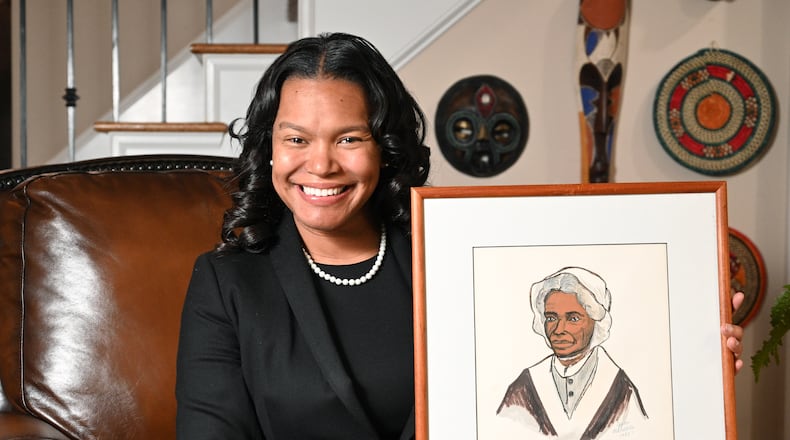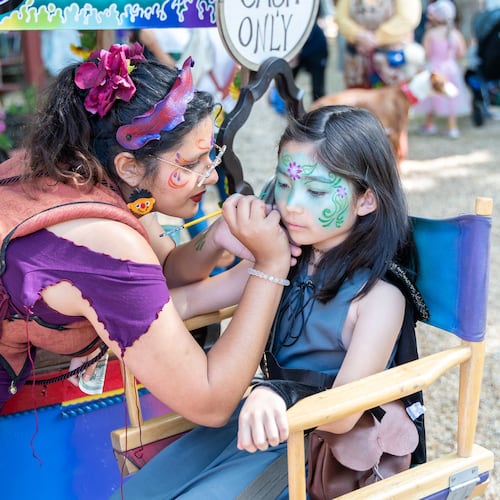EDITOR’S NOTE: This story is one in a series of Black History Month stories that explores the role of resistance to oppression in the Black community.
Sojourner Truth, a towering figure in the American story, accomplished what no Black woman had ever done.
She walked to freedom carrying her infant daughter, Sophia. Then she successfully sued a white man to secure the freedom of her son, Peter.
Her legacy doesn’t end there. Known until 1843 as Isabella Van Wagenen, she gave herself a new name. As Sojourner Truth, she became an itinerant preacher. She was a powerful speaker, who appeared at camp meetings, conventions and protests around the country, where she agitated for women’s suffrage and the end of slavery. Young parents continue to name their daughters “Sojourner,” two centuries later.
Imposing in her presence and casual in her orations, which were often spliced with humor, she was celebrated as a speaker who could move audiences to laughter and tears.
Credit: The National Portrait Gallery
Credit: The National Portrait Gallery
But today her legacy has become attached to words she never spoke, in an accent that was alien to her voice.
She appeared at a rally for women’s suffrage in 1851 in Akron, Ohio. Twelve years later, Frances Dana Gage, the organizer of the event, reported Sojourner Truth’s words in New York’s Independent newspaper.
The address became famous as the “Ain’t I a Woman?” speech and was filled with the kind of dialect familiar to fans of minstrel shows and “Uncle Tom’s Cabin.”
In Gage’s reporting, Truth opens with “Well, chillen, whar dar’s so much racket dar must be som’ting out o’kilter.” She goes on to debunk the idea that women need to be cosseted and protected:
“Nobody eber helps me into carriages or ober mud-puddles, or gives me any best place. And ain’t I a woman?” The speech — with the repeated refrain, “Ain’t I a woman?” — is emblazoned in the popular imagination, and has survived to the present, to be re-enacted by contemporary speakers from Kerry Washington to Cicely Tyson.
But Sojourner Truth grew up in Upstate New York, enslaved by a Dutch family, and spoke Dutch until the age of 9. According to her biographer, Nell Irvin Painter, her accent was far removed from the Southern Black English that is burlesqued in the “Ain’t I a Woman” speech.
Because Truth could neither read nor write, her story has come to us through other interpreters, almost all of them white, who used the handy caricatures of the day to make their subject more believable, more “Black.”
Painter, a professor emerita of history at Princeton University, is working on a new biography, called “Sojourner Truth Was a New Yorker and She Didn’t Say That.”
“The idea that we have a heroine in Sojourner Truth, yeah that’s right,” said Painter, speaking from her home in the Hudson Valley. “The idea that we have a heroine who said that phrase? Is not true.”
A remarkable discovery put Sojourner Truth back in the news last summer.
The documents from Isabella Van Wagenen’s lawsuit against Solomon Gedney, missing for 194 years, were rediscovered in New York’s Ulster County courthouse, the same building where the former slave filed the complaint.
“The people in the courts in Kingston had also assembled other documents, including probate records (from her previous enslaver) when she was a child, listed without a name: something like ‘negro wench.’ That is really chilling.”
In 1828 Solomon Gedney sold Peter to a relative in Alabama. Peter was an indentured servant at the time, on the verge of freedom, and New York’s laws made this sale illegal.
Painter said Gedney had the choice between two charges: being sued for kidnapping or being sued for enslavement, i.e. trafficking a child. Gesney picked the lesser charge, trafficking, and produced the boy, as required by the court.
Fifteen years later, in a spiritual epiphany, Isabella changed her name, and set out on a mission to help her people.
While the truth of her speech in Akron was modified by France Gage, whose version became legend years later, a local reporter, Marius Robinson provided a contemporaneous account that he published that year in the Salem Anti-Slavery Bugle.
In that account, Truth’s language is free of Southern Black dialect, and the phrase “ain’t I a woman?” doesn’t appear. But the sentiment remains, the conviction that a woman can work as hard as a man, and deserves the same rights given to a man.
Credit: ©Smithsonian National Portrait
Credit: ©Smithsonian National Portrait
Sojourner Truth yoked together the two significant human rights struggles of the day, the fight against slavery and the campaign to win the vote for women. Her mission carried her to Washington, D.C., where she met and conferred with President Abraham Lincoln, and to a cooperative farm in Northampton, Massachusetts, where she met Frederick Douglass, who had just published his autobiography.
Perhaps inspired by Douglass, she wrote her own story, with the help of a white collaborator, and the profits from the book allowed her to buy her own house.
In addition to her other accomplishments, by choosing her own new name, Sojourner Truth created a template for a tradition that continues in Black America.
“It’s almost a way to an alliance with the Kwanzaa principle of self-determination,” said Lita Hooper-Simanga, who taught English for 25 years at Georgia Perimeter College. “Who names us? We speak for ourselves, we name ourselves.”
Hooper-Simanga first fell in love with the name Sojourner when she met Sojourner Marable, the daughter of her University of Colorado professor Manning Marable.
Credit: Hyosub.Shin@ajc.com
Credit: Hyosub.Shin@ajc.com
Later, Lita Hooper married Michael, a professor of African American studies at Morehouse College, who dropped his Western name in the 1970s and adopted the Swahili name Simanga. The two of them would name their daughter Sojourner Simanga.
Sojourner Marable Grimmett is vice president of community outreach and marketing for Peach State Health Plan, and a South Fulton resident. Grimmett, whose name inspired the Simangas, said, “My namesake has shaped my life and my career.”
Sojourner “Soji” Simanga is 21 now, a senior at Kennesaw State University, and says she is inspired by the story behind both of her names. Of “Simanga” she said, “I love that he chose it,” and of “Sojourner” she said, “It’s a powerful statement that, yes, I have this given name, and I appreciate it.”
ABOUT THE SERIES
This year, the AJC’s Black History Month series will focus on the role of resistance to forms of oppression in the Black community. In addition to the traditional stories that we do on African American pioneers, these pieces will run in our Living and A sections every day this month. You can also go to ajc.com/black-history-month for more subscriber exclusives on the African American people, places and organizations that have changed the world.
About the Author
Keep Reading
The Latest
Featured






